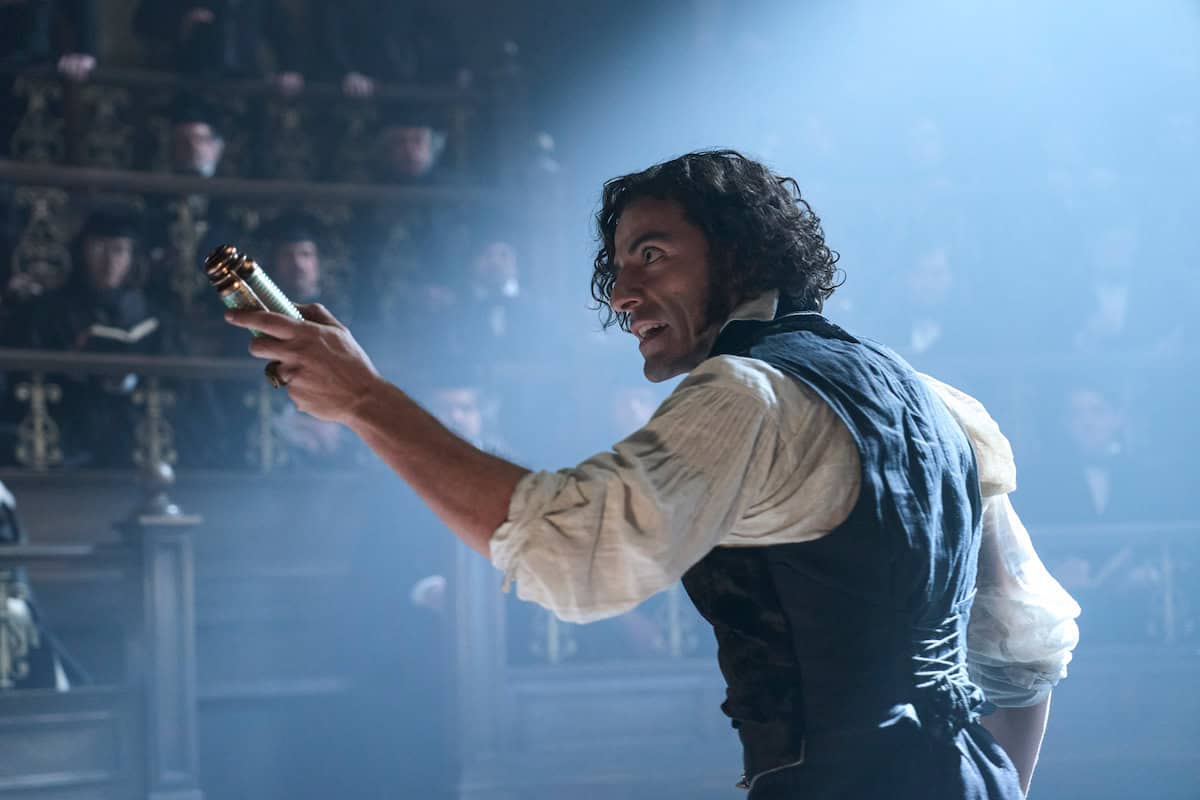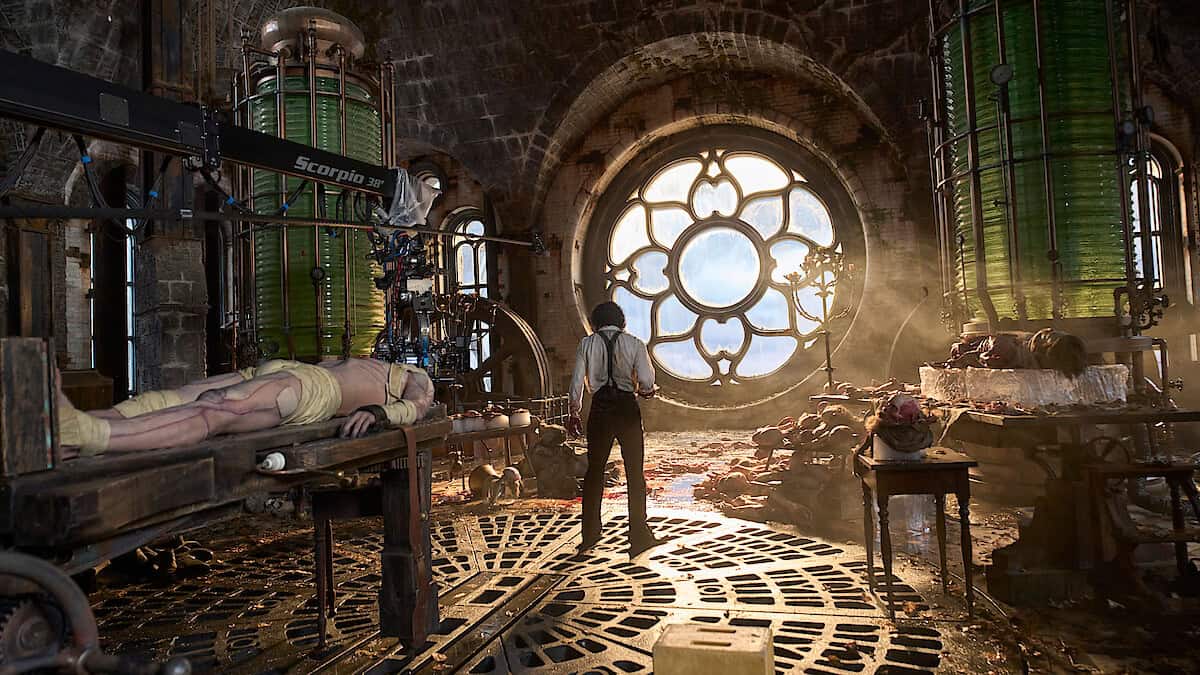Netflix fans are in for a treat as Guillermo del Toro’s highly anticipated adaptation of “Frankenstein” is set to premiere in November 2025. This marks a significant milestone for the acclaimed director who has expressed a long-standing passion for bringing Mary Shelley’s classic tale to life. The film will star Oscar Isaac in the lead role, with Mia Goth and Jacob Elordi rounding out the cast, promising a fresh interpretation of the iconic story by one of cinema’s most visionary filmmakers.
A first-look image released by Netflix offers a tantalizing glimpse of Oscar Isaac in character. While details remain limited, the visual has already generated excitement among film enthusiasts. The project represents the culmination of del Toro’s long-held dream, as he reportedly described a faithful “Miltonian tragedy” version of Frankenstein as a project he “would kill to make” as far back as 2007.
The film joins Netflix’s impressive lineup of fall 2025 releases, which includes Rian Johnson’s “Knives Out 3” and Noah Baumbach’s “Jay Kelly.” For del Toro fans, this project is particularly significant as it connects to his renowned affinity for monster narratives and gothic storytelling that has defined much of his acclaimed filmography.

A Cinematic Dream 50 Years in the Making
Guillermo del Toro’s Frankenstein is not just another reimagining of Mary Shelley’s gothic novel — it’s the culmination of a lifelong obsession. The Oscar-winning director has been vocal about his connection to the story, calling it a passion project he’s dreamed of making since childhood. Now, after decades of development hell, canceled scripts, and shifting studios, the film is real — and it’s headed to Netflix in November 2025.
An All-Star Cast Reanimates the Legend
Leading the film is Oscar Isaac as Dr. Victor Frankenstein, bringing an intense, cerebral energy to the role of the tormented scientist. Opposite him, Jacob Elordi takes on the role of the Creature — a significant departure from his typical roles, signaling a performance that leans into both tragic pathos and physical menace. Rounding out the cast is Mia Goth, who continues to establish herself as one of horror’s most exciting contemporary figures.
But the ensemble doesn’t stop there. The supporting cast includes Christoph Waltz, Felix Kammerer, Lars Mikkelsen, David Bradley, Charles Dance, and Ralph Ineson — a collection of heavyweights and rising stars that promises to deliver a multi-layered, performance-driven adaptation.
Del Toro’s Gothic Signature

Fans of del Toro know what to expect: stunning set design, meticulous practical effects, and an emotional core wrapped in the macabre. His take on Frankenstein is expected to lean heavily into the existential horror and moral ambiguity of Shelley’s novel — not just the monster, but the monstrousness of its creator. It’s a far cry from the traditional lightning bolts and angry villagers. Del Toro’s vision is more poetic, more tragic, and much more human.
Behind the Camera
The film was shot in Toronto, with principal photography beginning in February 2024 and wrapping in September. This tight but deliberate schedule allowed del Toro and his team to fully immerse the production in atmosphere and detail. As with his past works like Crimson Peak and Pan’s Labyrinth, the aesthetic is expected to lean into Victorian decay, chiaroscuro lighting, and haunting creature design. The first-look photos show a stark, almost painterly approach to visual storytelling, with Oscar Isaac’s Frankenstein appearing more haunted than mad.
A Theatrical-Streaming Hybrid Release
Though destined for Netflix, the film is also expected to get a limited theatrical release — a nod to del Toro’s commitment to preserving the cinematic experience. This dual approach mirrors the release strategy of his previous Netflix collaboration, Pinocchio, which earned the streamer an Academy Award and validated its push into auteur-driven prestige projects.
The Bigger Picture: A Horror Renaissance
Frankenstein is arriving amid a wave of renewed interest in classic horror. Universal is rebooting its monster universe (again), and Maggie Gyllenhaal’s The Bride is set to release the same year. But del Toro’s film stands apart. It isn’t just a rehash or modern update. It’s a return to the roots — both of the story and of horror itself — using Shelley’s themes of abandonment, guilt, and humanity’s reach beyond its grasp as its spine.
What to Expect
- A deeply faithful yet original interpretation of Shelley’s novel
- Introspective performances, especially from Isaac and Elordi
- Signature del Toro visuals with rich gothic detail
- A more emotionally driven monster, not just a creature of rage
- Potential awards season buzz following its dual-platform release
With the bar set high and the ingredients in place, Frankenstein is shaping up to be one of 2025’s most anticipated films — not just for horror fans, but for anyone who appreciates bold, character-driven cinema. Del Toro is poised to give us a Frankenstein that bleeds, grieves, and perhaps, finally, understands itself.
Key Takeaways
- Guillermo del Toro’s “Frankenstein” adaptation will premiere on Netflix in November 2025 with Oscar Isaac, Mia Goth, and Jacob Elordi in starring roles.
- The film represents a passion project for del Toro, who has wanted to create a faithful adaptation of Mary Shelley’s classic novel for nearly two decades.
- Netflix has released a first-look image of Oscar Isaac in character, building anticipation for what promises to be a visually striking interpretation of the gothic tale.
Background of Guillermo del Toro’s ‘Frankenstein’
Guillermo del Toro’s adaptation of Frankenstein represents the culmination of a decades-long passion project for the acclaimed filmmaker, drawing from both Mary Shelley’s original text and his lifelong fascination with the monster.
Influence of Mary Shelley’s 1818 Novel
Mary Shelley’s groundbreaking 1818 novel “Frankenstein; or, The Modern Prometheus” serves as the primary source for del Toro’s upcoming film. The original text explores themes of creation, responsibility, and the consequences of playing god—themes that align with del Toro’s frequent explorations of monsters and their creators.
The novel, written when Shelley was just 18 years old, introduced the world to Victor Frankenstein and his unnamed creature. Del Toro’s adaptation appears to be honoring the Gothic science fiction roots of Shelley’s work while bringing his distinctive visual style to the material.
The director has often expressed admiration for Shelley’s complex moral questions about science, humanity, and monstrosity—elements that will likely feature prominently in his interpretation.
Previous Adaptations and Influence on Culture
Frankenstein has been adapted countless times since James Whale’s iconic 1931 film starring Boris Karloff. This version cemented the flat-topped, bolt-necked image of the monster in popular culture.
Del Toro is known to be a collector of Karloff memorabilia, suggesting the classic film has influenced his perspective. However, many adaptations have strayed significantly from Shelley’s original vision.
The Frankenstein story has permeated culture deeply, becoming a shorthand for scientific hubris and unintended consequences. Films, television shows, novels, and plays continue to reinterpret the tale for new generations.
Del Toro’s version joins this extensive legacy while promising a fresh perspective on the material.
Guillermo del Toro’s Vision and Artistry in Adaptations
Del Toro has spent over a decade trying to bring his version of Frankenstein to screens. The project nearly materialized in 2018 before Universal Pictures canceled it, showing the director’s persistence in realizing this passion project.
His distinct visual style combines Gothic sensibilities with painterly compositions and practical effects. Films like “The Shape of Water” and “Pan’s Labyrinth” demonstrate his ability to create empathetic monsters and blend horror with emotional depth.
Del Toro’s adaptations typically remain faithful to their source material’s spirit while introducing unique artistic elements. His creature designs often feature intricate details and biological plausibility.
The Netflix-backed production features an impressive cast including Oscar Isaac, Jacob Elordi, Mia Goth, and Christoph Waltz, suggesting a prestige approach to the classic tale.
Announcement and Production Details
Netflix has officially revealed that Guillermo del Toro’s highly anticipated adaptation of “Frankenstein” will premiere in November 2025. The announcement included the first look at Oscar Isaac as Dr. Frankenstein, generating excitement among fans of both the filmmaker and Mary Shelley’s classic novel.
Official Announcement and Release Date
Netflix confirmed that “Frankenstein” will arrive on the streaming platform in November 2025. While the exact date hasn’t been specified yet, this release window positions the film as a major addition to Netflix’s fall 2025 lineup.
The announcement was accompanied by a striking first-look image featuring Oscar Isaac as Dr. Frankenstein. Critics have described the image as “stunning,” though it reveals little about the plot or specific direction del Toro is taking with the adaptation.
The film represents a passion project for del Toro, who has expressed interest in adapting “Frankenstein” for many years. In 2007, he mentioned it was a project he “would kill to make,” envisioning it as a faithful “Miltonian tragedy.”
Filming Locations and Production Insights
Production for “Frankenstein” has taken place across multiple locations, with significant filming occurring in Toronto, Canada, and London, England. These locations provide both modern studio facilities and the historic architecture that could complement del Toro’s Gothic visual style.
Del Toro’s adaptation has been years in the making. In January 2008, he revealed he was creating drawings to serve as the foundation for the film’s visual world. This lengthy development period suggests a deep commitment to realizing his vision for the classic story.
The production team has maintained considerable secrecy around the filming process. This approach aligns with del Toro’s previous work, where he often preserves mystery around his projects until their release.
Creative Team and Production Design
Oscar Isaac leads the cast as Dr. Frankenstein, bringing his considerable dramatic talents to the iconic role. Del Toro has assembled an impressive creative team to realize his vision of Mary Shelley’s classic novel.
The film follows del Toro’s previous successful collaboration with Netflix on “Pinocchio,” which won the Academy Award for Best Animated Feature. His distinct visual style and storytelling approach have become highly valued by the streaming platform.
Del Toro’s adaptation promises to be visually distinctive, as he’s known for his meticulous attention to production design and world-building. His previous work on films like “The Shape of Water” and “Pan’s Labyrinth” demonstrates his ability to create immersive, fantastical worlds grounded in emotional storytelling.
Production design for “Frankenstein” likely draws inspiration from del Toro’s early concept drawings, created as far back as 2008, ensuring a cohesive and carefully crafted visual identity for the film.
Cast and Characters
Guillermo del Toro’s ‘Frankenstein’ brings together an impressive ensemble of actors to portray the complex characters from this reimagined classic tale. The film features Oscar Isaac, Mia Goth, Jacob Elordi, and Christoph Waltz in key roles, each bringing unique qualities to this gothic narrative.
Oscar Isaac as Victor Frankenstein
Oscar Isaac takes on the pivotal role of Dr. Victor Frankenstein, the brilliant but obsessive scientist whose experiments in creating life lead to unforeseen consequences. Isaac, known for his versatility and intensity in films like “Ex Machina” and “Dune,” brings gravitas to the character of Frankenstein.
His portrayal is expected to explore the moral complexities and psychological torment that define Victor’s journey. The character appears to be reimagined as part of del Toro’s vision for a “Miltonian tragedy” version of the story.
Production notes suggest Isaac’s Frankenstein will showcase the character’s descent from scientific ambition to regret and horror at his creation. This interpretation may offer a more nuanced view of Victor than previous film adaptations.
Supporting Cast Introductions
Jacob Elordi is rumored to portray the Creature, Frankenstein’s infamous creation. His casting suggests a potentially different approach to the monster, possibly emphasizing the creature’s eloquence and emotional depth from Mary Shelley’s original novel.
Mia Goth joins the cast in what many speculate is the role of Elizabeth, Victor’s adopted sister and eventual wife in the source material. Goth’s recent work in horror films makes her an intriguing addition.
Christoph Waltz appears as Dr. Pretorius, who according to search results tracks down Frankenstein’s monster to continue Victor’s experiments. Ralph Ineson, known for his distinctive voice, has also joined the ensemble.
Additional cast members include David Bradley, Charles Dance, Lars Mikkelsen, Felix Kammerer, and Christian Convery in undisclosed roles.
Character Dynamics and Roles
The relationships between characters appear to be a crucial element in del Toro’s adaptation. The dynamic between Victor Frankenstein and his creation will likely form the emotional core of the film, exploring themes of creator versus creation.
Dr. Pretorius’ mission to find the creature “forty years after” suggests this adaptation may span a longer timeline than previous versions. This could allow for deeper character development and exploration of long-term consequences.
The inclusion of Elizabeth’s character potentially adds emotional complexity and moral counterweight to Victor’s scientific ambitions. Her relationship with Victor often represents the humanity he risks losing.
Del Toro’s filmography suggests he will emphasize the gothic romance elements while examining the psychological dimensions of these characters. His signature visual style will likely enhance the portrayal of these iconic literary figures.
Thematic Exploration and Interpretation
Del Toro’s adaptation of Frankenstein promises to explore enduring themes from Mary Shelley’s classic novel through his distinctive visual style and storytelling approach. His version likely examines the boundaries of creation, the responsibilities of creators, and the nature of monstrosity.
The Modern Prometheus and its Relevance
Frankenstein is subtitled “The Modern Prometheus,” referencing the Greek titan who stole fire from the gods to give to humanity. Del Toro’s adaptation will likely emphasize this theme of dangerous knowledge and technological overreach that resonates strongly today.
In our era of artificial intelligence, genetic engineering, and biotechnology, the cautionary tale of Victor Frankenstein carries renewed significance. The scientist who creates life without considering consequences mirrors contemporary ethical dilemmas in scientific advancement.
Del Toro’s visual storytelling excels at creating empathy for the monstrous, suggesting his version will explore how human ambition and scientific progress can lead to unintended consequences. His previous works indicate he may position Frankenstein as a warning about technological hubris while maintaining nuance rather than simplistic moralizing.
Frankenstein’s Monster and the Tragic Creation
The creature in Frankenstein represents one of literature’s most tragic figures – rejected by its creator and society despite its innate desire for connection. Del Toro’s filmography consistently empathizes with outcasts and monsters, suggesting his adaptation will deeply explore this aspect.
Oscar Isaac’s casting as the monster hints at a performance that may capture both the creature’s terrifying power and its profound vulnerability. Del Toro typically presents monsters with complexity and humanity, often positioning them as more sympathetic than their human counterparts.
The director’s fascination with gothic horror and romanticism makes him well-suited to present the creature’s existential loneliness and yearning for acceptance. His visual style, with its emphasis on texture and physical detail, will likely create a monster that is simultaneously frightening and heartbreaking.
The Notion of the Mad Scientist in Contemporary Times
Victor Frankenstein represents the archetype of the mad scientist whose obsession overrides ethical considerations. Del Toro’s interpretation will likely examine how this character reflects modern concerns about unchecked scientific advancement.
The director often explores the corrupting influence of ambition and obsession in his films. His version of Frankenstein may investigate how brilliant minds can become blinded by the potential of their discoveries, neglecting to consider their broader implications.
Del Toro’s previous works suggest he might present Frankenstein not as simply mad, but as tragically human – driven by grief, ambition and hubris. This nuanced portrayal could encourage viewers to reflect on the responsibilities scientists and creators have toward their innovations and society.
Integration in Guillermo del Toro’s Portfolio
Guillermo del Toro’s upcoming “Frankenstein” adaptation represents a natural evolution in his filmography, continuing his fascination with monsters and outsiders through his distinctive visual style and emotional storytelling.
Similarities with ‘The Shape of Water’ and ‘Pinocchio’
Del Toro’s “Frankenstein” shares thematic DNA with his Oscar-winning film “The Shape of Water” and his acclaimed “Pinocchio” adaptation. All three works explore the concept of created beings seeking connection in a world that views them as monstrous or unnatural.
“The Shape of Water” examined the relationship between a mute woman and an amphibian creature, while “Pinocchio” reimagined the wooden boy as an outcast in fascist Italy. These films demonstrate del Toro’s ability to find humanity in the inhuman.
His signature visual approach—combining gothic aesthetics with tender emotional cores—appears evident in the first-look image of Oscar Isaac as Victor Frankenstein. The dark, atmospheric setting echoes his previous work while promising his unique interpretation of Mary Shelley’s classic novel.
Del Toro’s Storytelling Approach in Dark Fantasy
The filmmaker’s “Cabinet of Curiosities” anthology series further illustrates his fascination with macabre storytelling and monster-focused narratives. Del Toro typically subverts expectations by presenting “monsters” as sympathetic protagonists rather than villains.
His artistic sensibilities shine through meticulous production design and practical effects, suggesting “Frankenstein” will likely feature tangible creature work rather than relying solely on CGI. Del Toro’s films often employ color psychology to create emotional resonance.
The November 2025 release continues the director’s relationship with Netflix, which previously distributed his “Pinocchio” to critical acclaim. This partnership has allowed del Toro greater creative freedom than traditional studio systems might permit for such dark material.
“Frankenstein” will likely showcase del Toro’s talent for blending literary analysis with personal vision, reinterpreting classic material through his uniquely humanist lens.
Expectations and Cultural Impact
Guillermo del Toro’s ‘Frankenstein’ adaptation carries significant weight in both cinema and broader cultural spheres, with anticipation building across different artistic communities.
Anticipation from Audiences and the Film Industry
The announcement of a November 2025 release date for del Toro’s ‘Frankenstein’ has generated considerable excitement. Film enthusiasts and critics are particularly intrigued by the stellar cast assembled for this project.
Oscar Isaac’s portrayal of Victor Frankenstein has become a major talking point. His transformation into the mad scientist character, glimpsed in Netflix’s first-look image, showcases the actor’s versatility following his acclaimed performances in various genres.
The combination of Jacob Elordi as the monster alongside Mia Goth and Christoph Waltz has positioned this film as potentially one of Netflix’s most prestigious offerings of 2025. Industry insiders view this as Netflix’s continued push into high-quality original filmmaking with established directors.
Del Toro’s reputation for visual storytelling and monster narratives makes him an ideal choice for adapting Mary Shelley’s classic novel. His previous success with Gothic elements and complex creature characters suggests this adaptation will honor the source material while offering fresh perspective.
Potential Influence on Future Arts and Media
Del Toro’s ‘Frankenstein’ is poised to influence multiple artistic domains beyond cinema. The director’s distinctive visual style could inspire new approaches in Gothic art and design across various media.
The film may spark renewed interest in Mary Shelley’s original novel and classic monster narratives. Educational institutions might see increased enrollment in literature courses examining Gothic fiction and monster theory.
Theater productions and dance companies often develop adaptations inspired by successful film versions of classic stories. The emotional and physical performances in del Toro’s film could influence new stage interpretations of ‘Frankenstein.’
Music composed for the film might also leave a lasting impact. Del Toro’s previous collaborations with composers have produced memorable scores that extend beyond the cinema experience.
The film’s release could coincide with museum exhibits exploring the history of Frankenstein adaptations. This cultural phenomenon often extends to fashion, with designers creating collections inspired by Gothic themes and characters from influential films.
Marketing and Promotion
Netflix has begun an extensive marketing campaign for Guillermo del Toro’s ‘Frankenstein’ ahead of its November 2025 release. The streaming giant has strategically revealed the first look at Oscar Isaac in character, generating significant buzz across social media platforms and entertainment news outlets.
Next on Netflix Campaign
Netflix has positioned ‘Frankenstein’ as a centerpiece in its “Next on Netflix” promotional initiative. The first-look image revealing Oscar Isaac’s transformation was released in early 2025, immediately capturing attention across entertainment media. This strategic reveal, occurring approximately nine months before the film’s release, has given audiences time to build anticipation.
The streaming platform has integrated ‘Frankenstein’ into its rotating showcase of upcoming premium content. Netflix subscribers now see teasers for the film when logging into their accounts.
Behind-the-scenes content featuring del Toro’s distinctive visual style has been gradually released through Netflix’s social media channels. This drip-feed approach maintains consistent public interest while allowing the platform to save major reveals for closer to the release date.
Collaborations with Influencers and the Mainstream Media
Netflix has partnered with horror and film enthusiasts across YouTube, TikTok, and Instagram to build grassroots excitement. These influencers have received exclusive access to production details and design elements from del Toro’s reimagining of the classic tale.
Entertainment journalists have featured the project prominently, with outlets like Variety highlighting the film’s star-studded cast and unique visual approach. Del Toro himself has participated in select interviews discussing his personal connection to Mary Shelley’s novel.
Netflix has also organized panel discussions with literary scholars and horror genre experts to contextualize this new adaptation. These discussions explore del Toro’s distinctive storytelling approach and his respect for the source material.
Frequently Asked Questions
Guillermo del Toro’s adaptation of Frankenstein brings together an impressive cast and his signature visual style for a November 2025 release on Netflix with a confirmed theatrical run.
What is the release date for Guillermo del Toro’s adaptation of ‘Frankenstein’?
Guillermo del Toro’s ‘Frankenstein’ is scheduled to premiere in November 2025 on Netflix. The exact release date has not yet been announced and will be revealed at a later time.
The film will also have a theatrical release, as confirmed by del Toro himself on BlueSky in November 2024. This dual release strategy will allow audiences to experience the film both in theaters and on the streaming platform.
Who has been cast in the leading roles of Guillermo del Toro’s ‘Frankenstein’?
Oscar Isaac leads the cast of ‘Frankenstein,’ with Netflix releasing a first-look image featuring him in the film. The striking image has already generated significant buzz among fans of both the actor and director.
The film features other notable actors, though complete casting details remain partially under wraps. Del Toro is known for assembling stellar ensembles for his projects, and ‘Frankenstein’ appears to continue this tradition.
What thematic elements will Guillermo del Toro explore in his ‘Frankenstein’ movie?
Del Toro has expressed his desire to create a “Miltonian tragedy” version of Frankenstein, suggesting the film will explore profound themes of creation, abandonment, and moral responsibility. This approach aligns with his previous statements about wanting to make a faithful adaptation.
The director’s body of work demonstrates his interest in outcasts and monsters as sympathetic figures. His ‘Frankenstein’ will likely examine the humanity within monstrosity and the monstrous potential within humanity.
Will Guillermo del Toro’s ‘Frankenstein’ stay true to Mary Shelley’s original novel?
Del Toro has previously described his vision for ‘Frankenstein’ as a faithful adaptation. He has long been interested in crafting a version that honors the source material’s depth and complexity.
The project has been in development for many years, with del Toro mentioning as far back as 2007 his intention to create a faithful version. His admiration for the novel suggests his adaptation will maintain the core philosophical questions while adding his distinctive artistic vision.
How will Guillermo del Toro’s visual style influence his version of ‘Frankenstein’?
The first-look image released by Netflix already showcases del Toro’s unmistakable visual aesthetic. His attention to detail and atmospheric cinematography appear to be central elements of this adaptation.
Del Toro mentioned in 2008 that he was creating drawings to establish the world of the film. This hands-on approach to visual development is characteristic of his filmmaking process and suggests ‘Frankenstein’ will feature meticulously crafted environments and creature designs.
Have any trailers or teasers been released for Guillermo del Toro’s ‘Frankenstein’?
Currently, only a single first-look image has been released for ‘Frankenstein.’ This image shows Oscar Isaac in character and has been described as “stunning” despite revealing little about the plot.
With the film set for a November 2025 release, trailers and additional promotional materials will likely begin appearing several months before the premiere date. Netflix typically releases teasers for major projects 6-8 months before release.







